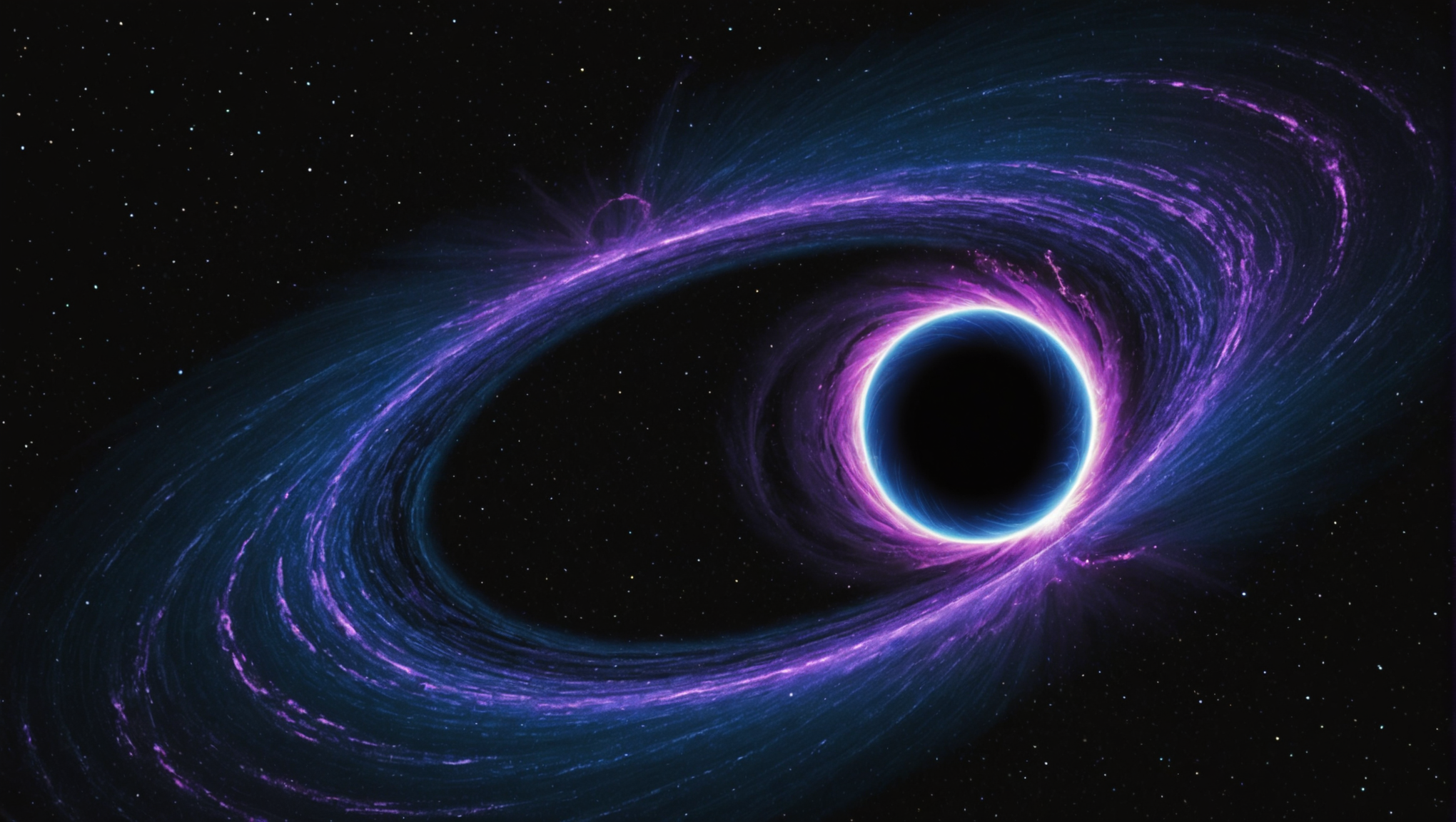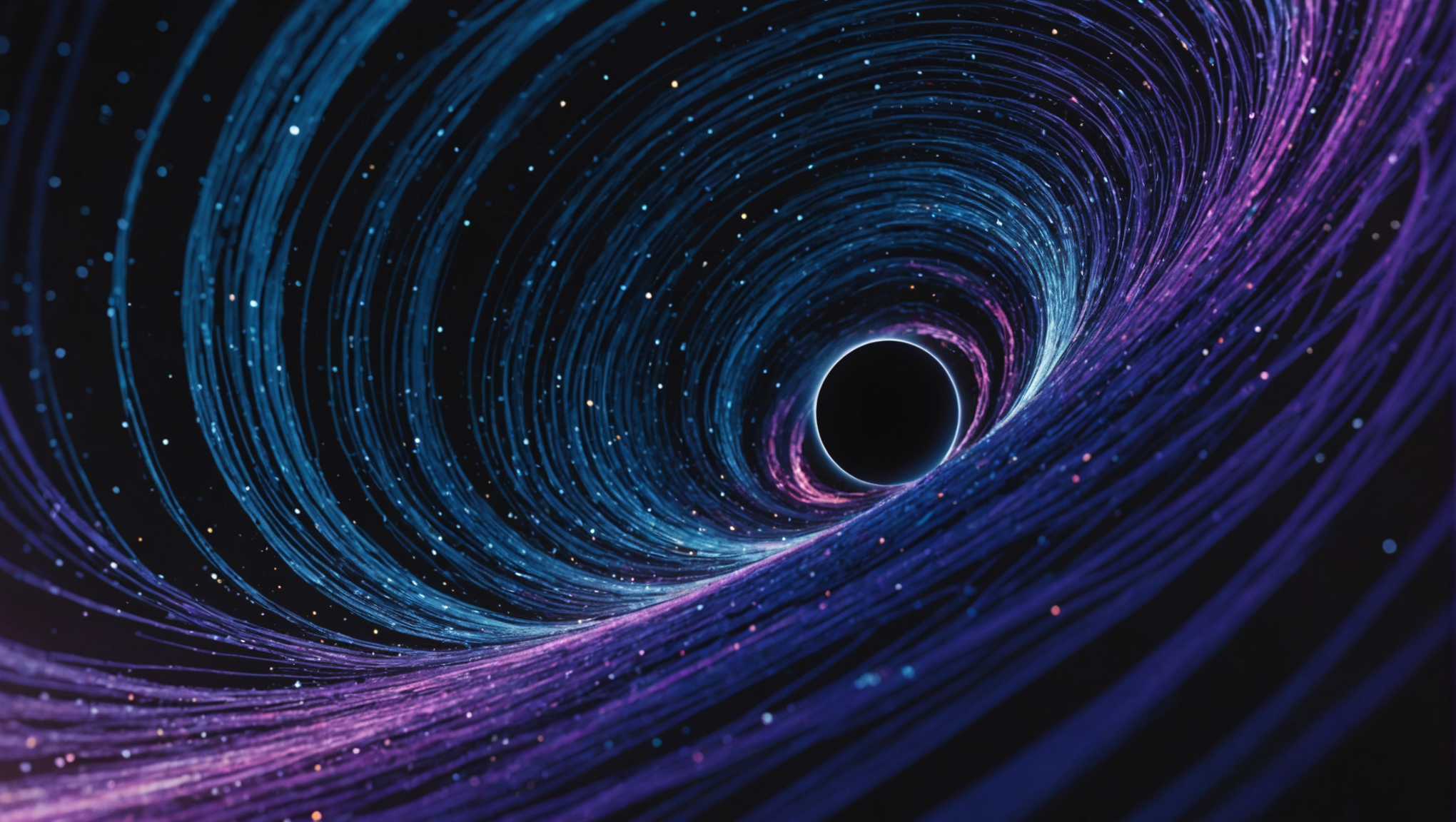Whispers of the Abyss in a Cosmic Ballet

Understanding the Dark Side of Cosmic Phenomena
In the vastness of the universe, the cosmos is not merely a spectacle of beauty and wonder; it is also a dark theater where extreme phenomena unfold, challenging our understanding of reality itself. One of the most haunting aspects of this cosmic stage is the presence of black holes and the enigmatic nature of dark matter. These elements push the boundaries of our comprehension, contorting the fabric of reality and revealing unsettling truths about the universe.
To grasp the enormity of black holes, one must first understand their formation. Born from the cataclysmic death of massive stars, black holes are regions of space where gravity is so intense that not even light can escape. The critical moment occurs when a star exhausts its nuclear fuel, causing it to collapse under its own weight. As it implodes, it compresses its mass into a singularity, a point of infinite density that defies our conventional understanding of physics. Surrounding this singularity lies the event horizon, the threshold beyond which nothing can return—a cosmic cliff from which no traveler can return.
The allure of black holes lies in both their terrifying capabilities and the mysteries they embody. They are not simply voids in space; they’re ravenous giants that consume all matter that ventures too close. The act of being drawn into a black hole evokes visceral fears, illustrating a process dubbed “spaghettification,” where gravitational forces stretch objects into thin, elongated shapes as they approach the event horizon. The imagination reels at the thought of what it must be like to witness such an end, where the normal laws of physics no longer apply.
As our understanding of these celestial phenomena deepens, we confront profound questions surrounding the nature of space and time. Black holes operate under the strange dance of relativity, warping spacetime itself. Time behaves differently in their vicinity; an observer falling into a black hole experiences time as a relatively normal flow, while to an outside observer, it slows to a crawl. This interplay leads us to ponder: what lies beyond the event horizon? Is there a continuation of existence, or does the cosmos simply swallow up any essence that crosses this boundary?
But black holes are not the only phenomena that challenge our understanding. Dark matter adds another layer of enigma. Accounting for approximately 27% of the universe’s mass-energy content, dark matter does not emit, absorb, or reflect light, rendering it invisible to conventional detection methods. Yet, its gravitational influence is pivotal in shaping galaxies and structures throughout the cosmos. The existence of dark matter raises unsettling questions about the material that constitutes the universe. What are these unseen particles, and why can’t we detect them directly? Could it be that ordinary matter represents a mere fraction of reality?
Current models fail to account for the behavior of galaxies in terms of visible matter alone; the rotation of galaxies suggests a significant amount of mass must be present to hold them together. This implies that dark matter serves as the hidden scaffolding of the universe, a vital component desperately shrouded in mystery. However, the chilling possibilities of dark matter do not end with its characteristics; rather, they challenge our very theories of cosmology and what we presume to be the fabric of the universe itself.
The implications of these phenomena extend beyond mere astrophysical quandaries. They ignite existential contemplations about our place within the grand design of the cosmos. If we are surrounded by such unimaginable darkness and complexities, what does that mean for humanity? As we gaze into the abyss of the universe, we may find that we are not just spectators but players in a cosmic drama filled with both terror and wonder.
Understanding the dark side of cosmic phenomena compels us to delve deeper into the mysteries of black holes and dark matter. They challenge our notions of existence and force us to confront the unknown. Each revelation not only enriches our scientific knowledge but also fosters a greater appreciation of the delicate balance of forces that shape our universe, urging us to explore further and understanding more about the intricacies of the cosmos.

The Terrifying Appeal of Black Holes
As we delve further into the terrifying allure of black holes, we must confront the profound implications they hold for our understanding of reality. The sheer power of these cosmic enigmas evokes both fascination and fear—as if we are peering into the abyss of a great and terrible unknown. The existence of black holes not only reshapes astrophysical models but also introduces questions about our very perception of time, space, and existential continuity.
One of the most haunting aspects of black holes is their event horizon, a boundary separating the observable universe from regions where traditional laws of physics cease to operate. Crossing this threshold transforms the nature of one’s existence into something unfathomably chaotic. For an adventurer brave enough to approach a black hole, the process of spaghettification represents a visceral illustration of this terror: as they draw nearer, the gravitational forces acting on their body would become intensely asymmetric, elongating them into strands like spaghetti. The physical manifestation of such cosmic forces raises unsettling thoughts about the fragility of matter itself. As we contemplate this, we cannot help but question the limits of our scientific comprehension and the nature of reality itself.
Furthermore, the immense gravitational pull of black holes influences the very fabric of spacetime around them. According to Einstein’s theory of relativity, massive bodies warp spacetime, creating a landscape that distorts our linear understanding of time. When observing an object falling into a black hole, we find that, from an outside perspective, time appears to slow to a crawl as the object approaches the event horizon. This paradoxical behavior poses deep philosophical inquiries about time, causality, and the nature of existence—what happens to the essence of consciousness as it ventures across the event horizon? Is that part of the self obliterated, or can it persevere in some enigmatic form? These questions, while theoretical, strike at the core of human inquiry.
The multimedia engagement of black holes also reveals their interconnectedness with other cosmic phenomena. They’re not isolated entities; many reside at the centers of galaxies, exerting profound influences on their surroundings. Supermassive black holes, which can possess masses equivalent to millions or billions of suns, shape galaxy formation and evolution through their gravitational pull and energetic feedback mechanisms. The accretion disc of material spiraling into a black hole emits tremendous amounts of radiation, including x-rays and gamma rays, profoundly affecting star formation rates and the dynamics of surrounding gas clouds. This cosmic interplay serves as a dark reminder that the universe is interwoven with the concepts of creation and destruction, where the cataclysmic events of one entity can nurture the growth of another.
Moreover, detection techniques for identifying black holes further amplify their terrifying allure. While these entities manifest invisibly, their presence is inferred through the gravitational influences they impose on companion stars or their distinctive x-ray emissions from heated accretion discs. For instance, in binary systems, where a black hole siphons material from a neighboring star, we can observe the catastrophic ballet of cosmic forces through high-energy emissions that illuminate the darkness. The technological advancements that allow us to find these hidden giants evoke a profound sense of cosmic intimacy, reminding us of our relationship with the universe and our vulnerability in its grand design.
The relentless pursuit of knowledge regarding black holes pushes the boundaries of theoretical physics, prompting researchers to explore novel paradigms that could unite quantum mechanics with general relativity. Such efforts aim to unravel the mysteries contained within black holes and may lead to groundbreaking discoveries about the fundamental laws governing the cosmos. Yet, the intricate quandaries surrounding black holes also invoke humility, as they display the limits of our understanding and how much there remains to be explored.
Ultimately, the embrace of black holes as entities infused with terror and allure not only fuels scientific inquiry but also evokes a poetic reflection on existence. They challenge us to confront both the psychological tremors of the unknown and the magnificent complexity of the universe. In contemplating these dark giants, we find ourselves grappling with profound existential questions and marveling at the broader narrative of cosmic continuation—a narrative that invites us to explore further and dream deeper, even as we stand on the precipice of the void.

The Intricacies of Cosmic Voids and Rogue Planets
As we venture further into the solar system’s less charted realms, we come face to face with two intriguing cosmic phenomena: cosmic voids and rogue planets. Cosmic voids are expansive areas of space that contain significantly fewer galaxies than their neighboring regions, presenting vast stretches of emptiness that can span hundreds of millions of light-years. These voids raise profound questions about the structure and evolution of the universe. They play an important role in influencing the distribution and dynamics of galaxies, acting almost as the gravitational scaffolding that defines the cosmic architecture we observe today.
The formation of cosmic voids is intricately tied to the evolution of the universe. Following the Big Bang, slight fluctuations in matter density allowed for the clumping necessary to form galaxies and clusters, leaving behind these vast, relatively empty expanses. Scientists estimate that voids make up about 80% of the total volume of the universe yet contain only around 20% of its mass. The presence of these voids can disrupt gravitational interactions, leading to what we see as the intricate web of the cosmos—a complex arrangement where galaxies tend to cluster along filaments of denser matter while avoiding the emptiness of the voids. This dynamic interplay challenges our understanding of cosmic evolution, highlighting how these seemingly lifeless expanses of space serve as influential players in the grand tapestry of the universe.
Rogue planets, on the other hand, present a different yet equally captivating facet of cosmic intrigue. These are celestial bodies that wander through space unbound to any star. Estimates suggest that there may be billions of such planets in our galaxy alone, and they could provide incredible insights into the processes of planet formation and the potential for life beyond our solar system. Rogue planets may have originated in traditional star-forming regions, only to be ejected due to gravitational disturbances from other massive bodies during the chaotic collisions that define vibrant stellar birthplaces. Or they may have formed in isolation, cast adrift in the darkness of space.
One of the most mesmerizing features of rogue planets is their potential to harbor life. Although they drift in isolation, some may possess subsurface oceans insulated by thick layers of ice, offering the possibility for microbial life to exist in extreme conditions far from the warmth of a star. This invites us to reconsider our understanding of habitability, suggesting that life might thrive in environments we have traditionally deemed inhospitable. Rogue planets challenge our notions about what constitutes a planetary system and complicate the parameters we use to define life itself. If life can exist independent of a planetary parent star, could it mean we are only scratching the surface of what is possible in the vastness of the universe?
Explorations into voids and rogue planets also evoke profound philosophical questions. The existence of cosmic voids compels us to grapple with the notion of ‘nothingness’ on a grand scale. In understanding these vast expanses, we are forced to rethink how we perceive the distribution of matter and the very nature of existence itself. Similarly, rogue planets prompt existential inquiries regarding what it means to be ‘at home’ in the universe and the vast libraries of potential histories these planets may hold. Are they markers of a chaotic past, or do they represent new beginnings, untouched by the development of a home star?
Moreover, the intricate relationship between cosmic voids and rogue planets offers a window into understanding the forces that shape our universe. The gravitational influences of voids can affect how rogue planets interact with other celestial entities. As they traverse the emptiness of cosmic voids, rogue planets could illuminate the ways in which cosmic landscapes evolve over eons, shifting alliances and creating new cosmic stories. The dance of these lonely worlds amid vast empty spaces challenges our conventional views of structure in the universe, reminding us that, even in stillness, the cosmos is a theater of incessant activity.
As we reflect on the interplay between voids and rogue planets, we acknowledge a tension—a balance between creation and absence, activity and dormancy. Each discovery in this field invites us to peel back the layers of cosmic mystery further, encouraging an exploration that calls not just for scientific understanding, but for introspection on our place within the universe. The ecstasy of discovery sits alongside the fear of isolation, prompting us to question our definitions of sentience and existence as we gaze longingly into the deep dark of space, ever yearning for connection in a cosmos that can be both chillingly empty yet wondrously full of potential.
The Eerie Nature of Gamma Ray Bursts and Cosmic Rays
The eerie nature of gamma ray bursts (GRBs) and cosmic rays brings to the forefront some of the most violent, high-energy phenomena in the universe, illuminating the unfathomable processes occurring across intergalactic distances. These extraordinary events arise from catastrophic situations in the cosmos, whether it be the spectacular explosion of massive stars going supernova or the violent merger of neutron stars. Each gamma ray burst encompasses an energy output that can exceed what an entire galaxy would seem to generate over its lifespan, manifesting as brief yet intense flashes of gamma radiation, visible across billions of light-years.
The vast power of gamma ray bursts is just one aspect that evokes both awe and fear. In fact, if such an event were to occur within a few thousand light-years of Earth, the consequences could be dire. The overwhelming energy released could strip away our planet’s protective ozone layer, leading to increased levels of ultraviolet radiation that could jeopardize life as we know it. This somewhat primal fear of the cosmos reflects our vulnerability in an ever-unfolding universe, highlighting how we exist within a delicate balance influenced by phenomena far beyond our immediate control.
Gamma ray bursts occur in two main categories: long-duration and short-duration bursts. Long-duration GRBs typically stem from the collapse of massive stars, leading to the formation of black holes. As material falls into the black hole, it releases an incredible energy surge, manifesting as a gamma ray burst detectable from immense distances. Moreover, short-duration GRBs are associated with the mergers of dense neutron stars, where gravitational waves are emitted alongside the bursts of energy. Together, these events demonstrate the dramatic interactions that take place in the scales of time and energy that dwarf human comprehension.
As astronomers study these bursts, they not only illuminate the violent lifestyle of celestial objects but also serve as unique laboratories for examining high-energy astrophysical processes. Each burst acts like a cosmic beacon, shedding light on the conditions that prevailed in the universe billions of years ago. Their brief duration—lasting from milliseconds to mere minutes—makes them both elusive and mesmerizing, posing questions about the exact mechanisms driving their explosive behavior and the underlying science of matter under extreme conditions.
In addition to gamma ray bursts, cosmic rays also present a fascinating branch of study within astrophysics. These high-energy particles, predominantly protons and atomic nuclei, travel at nearly the speed of light and originate from various sources, including the Sun and distant supernovae. When cosmic rays interact with Earth’s atmosphere, they generate showers of secondary particles, creating a cascade of energy that can introduce potential risks to human health and technology. Their complications include potential cellular damage, mutation risks, and the influence they may have on cloud formation—factors that hearken to the intricate relationship between cosmic phenomena and Earthly existence.
Yet the nature of cosmic rays is not purely terrifying; they also inspire scientific intrigue. Researchers regard them as messengers from the vibrant cosmos, capable of enriching our understanding of the very building blocks of stellar evolution. By observing the interactions of cosmic rays with interstellar mediums, scientists gain insights into the conditions and processes that govern the universe’s dynamics. In this multifaceted realm, cosmic rays have the potential to provide crucial information about the mechanisms that underlie the formation of stars and galaxies.
As we contemplate the eerie aspects of gamma ray bursts and cosmic rays, we are invited to reflect on the intricate interplay between environment and existence. Both phenomena burst forth with incredible energy and chaotic beauty, revealing the delicate threads that weave together the fabric of our universe. They remind us that we are, at times, mere observers in a cosmic theater strewn with astonishing events, where the forces at play extend far beyond our understanding, challenging us to grapple with the vast uncertainties of our existence. In seeking a greater understanding of these phenomena, we unveil the mysteries that govern cosmic behavior while embracing the charm of an enigmatic universe that is forever at play.